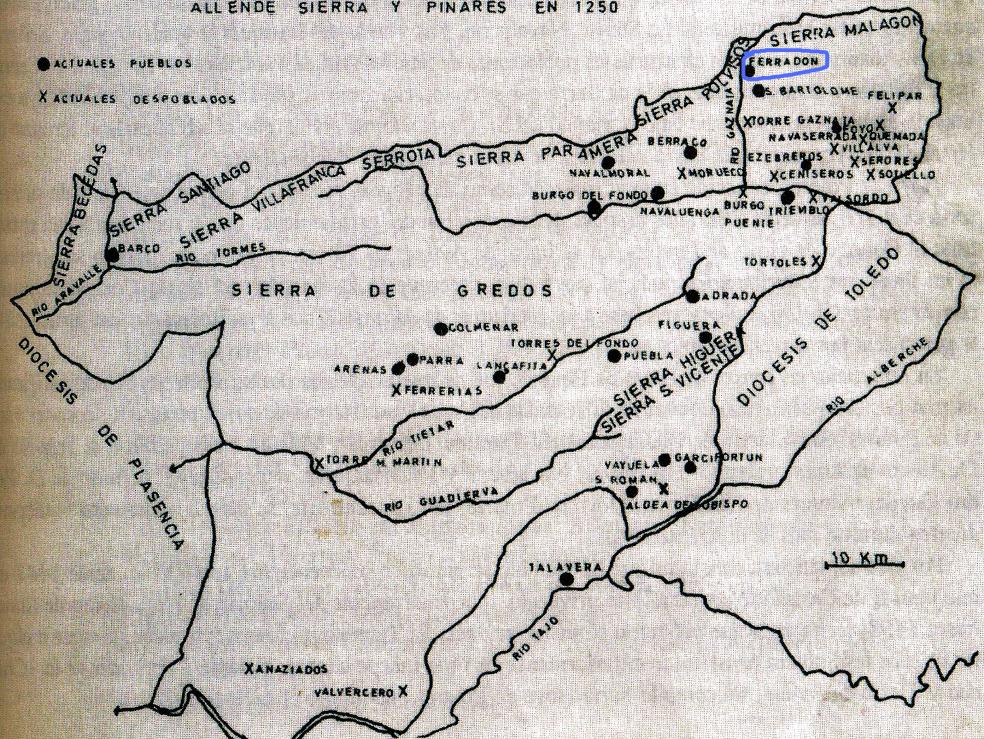
|
HERRADÓN DE PINARES |
|
HISTORY |
|
El Herradón is crossed by the river Gaznata from North to South. This river has got an irregular flow, rising high during the winter and almost dry during the summer. Its source is located near La Cañada, at the very point that divides the slopes of the river Voltoya (Duero’s basin) and the river Alberche (Tajo’s basin), and it traverses the village centre on a beautiful path. The river serves as a natural frontier between San Bartolomé and Santa Cruz de Pinares and goes on until it reaches the village of El Barraco, as it then flows in to the left bank of the river Alberche down in the Burguillo reservoir, measuring about four and a half leagues. El Herradón was the leading village in Tierra de Pinares in sending people for the colonization of America after its discovery: “Alonso Dávila López, son of Alonso Dávila and Catalina López, and Alonso García García, son of Martín García and María García, both from El Herradón (Ávila), set sail to the New World on 17th February 1517”. Concerning the economy, during the XIX century El Herradón harvested wheat, rye, barley, chickpeas, carobs, potatoes, linen, wool, and some fruits and vegetables; it bred sheep, goats, cows and pigs. It had two flour mills and one tile and brick kiln. Nowadays the village is still devoted to cattle breeding, with 1,800 sheep and 2,000 cows for 3,000 h. of pasture surface. Towards the end of the XVI century, El Herradón was the most populated village in the Tierra de Pinares region only after Las Navas del Marqués. This is listed in the census which was carried out during the reign of Philip II: “El Herradón has got a baptismal font and 200 residents.” In 1950 counted more than 1,000 people, but currently most of the 525 registered inhabitants are set in La Cañada. El Herradón celebrates its patron saint’s day of Our Lady of the Rosary on the first Sunday of October in a popular and warm atmosphere attracting a large crowd. The unstaffed station of Navalgrande or Canto del Pico and the station of La Cañada are part of the municipality. La Cañada station is at 1,360.1 meters above sea level, making it one of the highest in Spain. La Cañada today is an outstanding spot which enjoys excellent climate and landscape conditions during the summer and that is why its population greatly increases during the warm season. Continuing our historical, touristic overview, the village preserves architectural relics of noble Castilian descent, of which we can name: The parish church: authentic jewel of Gothic- Elizabethan style devoted to Saint Mary the Greater. It contains excellent coffered ceilings and altarpiece. The church creates a sense of architectural and stylistic harmony between the medieval bridge over the river Gaznata, the old well and the Town Hall, built in 1788 during the reign of Charles III, as stated in the inscription on its façade. Completing this nice trip, there is a hermitage on the way to La Cañada. El Herradón is worth the visit to gaze upon such a lovely village which has carried on with a strong, religious tradition for generations. This can be appreciated in every religious construction all over the region. There is also a hermitage devoted to San Peter from Alcántara in the site named “La Muela” which is currently closed. The legend tells that a child fell into a well. Saint Peter saved him from drowning inside and, to prevent more people from falling again inside, the well is closed inside the temple. Another story tells that during the Spanish Civil War a soldier took an eye and cut an arm off a statue of Saint Peter; for his actions, that soldier received the same fate. The elderly of the village tell that long ago the village was located elsewhere, but for one reason or another, it had to be moved to its current location: - Some say there were some lizards that poisoned the water. - Others say that the current position has more water and that it is less cold. |
